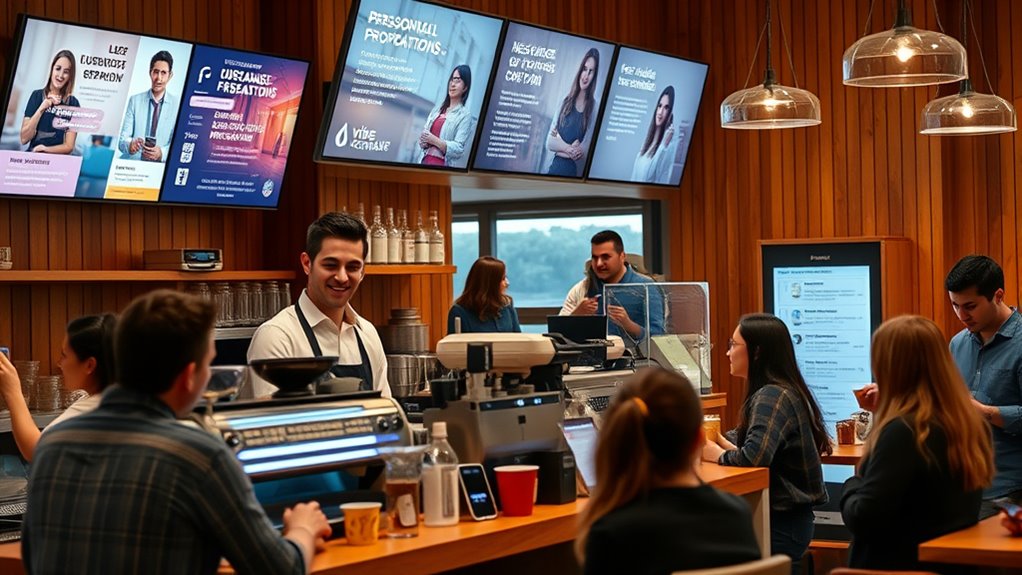A small business harnessed vibe coding to develop custom customer tools that enhanced user interaction and simplified operations. By using AI to generate code from plain language descriptions, they quickly built and tested prototypes, cutting down development time markedly. This allowed non-developers to actively contribute, fostering collaboration and innovation. As they adapted to user needs, they created a seamless experience that drove engagement. Discover how they navigated the challenges and achieved long-term success.
Key Takeaways
- A small business implemented vibe coding to quickly develop custom customer tools that enhanced service efficiency and responsiveness to market demands.
- The use of AI in vibe coding allowed non-developers in the team to contribute to the software creation process, speeding up prototyping.
- Automated code generation through vibe coding significantly reduced development costs and time, improving ROI for the small business.
- By centralizing data management, the business improved its marketing efforts and customer service, leading to better customer experiences.
- Regular feedback and iterative improvements ensured the customer tools remained aligned with user needs, fostering innovation and adaptability.
The Need for Custom Customer Tools

In today’s fast-paced business environment, custom customer tools aren’t just a luxury; they’re a necessity for staying competitive. You need to integrate multiple processes to streamline operations, reducing reliance on generic software that often misses the mark. By customizing your tools, you can improve efficiency and focus on what truly matters—serving your customers. Centralized data management means all your information is in one place, enhancing your marketing efforts and customer service. Plus, custom solutions eliminate need for multiple generic software packages and adapt to changing market demands and unique challenges, setting you apart from the competition. As businesses increasingly adopt AI-driven personal assistants, scalability guarantees you can grow without tech limitations, while long-term cost efficiency makes tailored solutions a smart investment for your business’s future. Additionally, ensuring your tools are designed with nutritional guidelines in mind can lead to better customer engagement and satisfaction. Moreover, leveraging natural language processing can enhance interactions and provide personalized experiences for your customers. Implementing low light office plants can also create a more inviting workspace, improving overall employee well-being and productivity.
Exploring Vibe Coding Technology

Vibe coding represents a revolutionary approach to software development, harnessing the power of AI to transform how you create applications. With this AI-dependent technique, you can describe problems in plain language, and the AI generates the necessary code. This shift allows you to focus on guiding and refining the output instead of manual coding. Vibe coding accelerates development speed, making it ideal for startups needing rapid prototypes. It democratizes software creation, enabling non-developers to contribute without extensive coding knowledge. However, while it excels at generating code, maintenance can be challenging, and the quality of the AI’s output varies. This innovative approach, often referred to as vibe coding, emphasizes collaboration between humans and AI in the software creation process.
Steps to Implement Vibe Coding

Harnessing the power of vibe coding requires a structured approach to implementation. Start with project planning by defining your goals, identifying features, and determining the role of AI. Create detailed task lists and set timelines. Additionally, leveraging predictive analytics can help anticipate user needs and refine your goals further. Fresh orange juice lasts 2-3 days when refrigerated, which can serve as a reminder to keep project timelines in mind. Iterative processes are also essential in fine-tuning your approach based on initial feedback. Understanding the importance of Software Development Life Cycle (SDLC) principles will further enhance the project’s structure.
Next, set up your development environment by choosing frameworks like Next.js and libraries such as Chakra UI. Configure AI-assisted tools and implement version control systems. Additionally, vibe coding emphasizes the importance of allowing developers to focus on high-level design while AI manages routine tasks.
Then, design a user interface using the component library, ensuring responsive layouts and user-friendly interactions. Integrate lightweight state management libraries to handle data effectively, leveraging AI for code generation.
Finally, conduct thorough testing with AI-generated tests, gather user feedback, deploy your application, and monitor its performance post-launch. This structured approach will streamline your vibe coding project.
Benefits Realized From Vibe Coding

While exploring the benefits of vibe coding, you’ll discover that it greatly enhances development efficiency and innovation. By automating code generation, vibe coding streamlines the development process, allowing you to spend less time on manual coding. This results in faster prototyping, enabling you to test ideas and validate products more quickly. With AI handling code writing, you can focus on high-level decisions, which speeds up overall development and reduces coding errors. Additionally, vibe coding helps smaller teams achieve significant revenue without extensive resources, lowering development costs and improving ROI. You’ll find that it not only fosters innovation but also enhances market positioning, allowing your business to adapt swiftly to changing customer needs and trends. This approach also facilitates faster development and cost savings, making it a game-changer for small businesses. Moreover, embracing continuous learning within your team can further leverage the benefits of vibe coding, ensuring that your business remains competitive in a rapidly evolving market.
Overcoming Challenges in Development

As you adopt vibe coding in development, you may encounter several challenges that require addressing. Inconsistent patterns can make code maintenance tough, and you might struggle to understand AI-generated code, leading to longer debugging times. Additionally, the lack of human oversight can exacerbate the complexity of maintaining these systems.
Technical debt can accumulate from quick AI solutions, while the lack of foresight in project architecture may result in disconnected code structures. Ensuring code readability is essential, as AI-generated code can be obscure. You’ll also need to maintain consistent coding practices to navigate the complexity of your codebase effectively. Regular code reviews and adopting best security practices will mitigate hidden inefficiencies and potential vulnerabilities, ensuring a smoother development process while enhancing your project’s overall quality.
Success Stories and Use Cases

Vibe coding has transformed the landscape of app development, showcasing its potential through a variety of success stories and use cases. You can quickly create functional prototypes using platforms like Replit, allowing you to develop without the lengthy cycles typical in traditional methods. Many businesses have successfully integrated AI tools, such as ChatGPT, to turn natural language requirements into actionable product descriptions. This innovative approach mirrors the AI-driven analytics tools that enhance decision-making in marketing. Engaging in creative practice not only streamlines development but also fosters a culture of innovation within teams. As highlighted in the book “The AI Bifurcation,” understanding the transformative role of AI is essential for businesses looking to adapt and thrive in this evolving landscape. Additionally, this method of development leverages AI-dependent programming techniques, which can significantly reduce time-to-market for new features. Whether you’re building custom web apps or engaging chatbots, vibe coding empowers you to deliver personalized customer experiences. This approach is particularly effective in finding business problems that can be addressed through innovative solutions.
Best Practices for Effective Implementation

Building on the success stories showcased in vibe coding, it’s important to implement best practices that assure effective outcomes.
First, specify your requirements clearly to guide the AI in generating accurate code. Use appropriate AI models for planning and execution, and define the project scope to avoid unnecessary complexity. Vibe coding emphasizes allowing AI to manage technical complexities, making it essential to focus on human ideation and direction.
Iterate based on initial outputs to refine your results. Leverage generative AI for design and combine models to enhance efficiency.
Utilize real-time feedback tools to quickly improve your code, and consider voice-driven coding for better accessibility.
Finally, manage non-determinism by implementing controls, regularly monitor code quality, and stay updated on the latest AI techniques to guarantee ideal Vibe Coding processes.
Future Growth and Opportunities With Vibe Coding

While traditional coding often limits participation to those with technical backgrounds, vibe coding opens doors for everyone, making software development more inclusive.
You’ll find that vibe coding reduces barriers, allowing non-developers to contribute meaningfully to projects. This accessibility encourages diverse teams, driving innovation and creativity. Additionally, user-centric software development is crucial as it aligns product features with actual user needs, enhancing the overall user experience. Implementing data-driven marketing strategies can help refine these user needs further by analyzing consumer behavior. Furthermore, leveraging retirement savings options can provide freelancers with financial stability as they navigate their unpredictable income. The rise of astrological compatibility in cultural beliefs can also inspire creativity among team members, fostering an inclusive environment. Developing emotional intelligence within these teams can further enhance collaboration and decision-making.
Moreover, vibe coding enhances efficiency, speeding up development and automating tedious tasks, which lets you focus on what truly matters.
Vibe coding streamlines development, automating repetitive tasks so you can concentrate on what truly matters.
As AI continues to advance, these tools will evolve, understanding business logic better and fostering natural collaboration between human and AI.
The economic impact could be significant, disrupting traditional coding industries and paving the way for new business models.
Embracing vibe coding means tapping into a future full of opportunities.
Frequently Asked Questions
What Initial Investment Is Required for Implementing Vibe Coding?
When you’re considering implementing vibe coding, your initial investment will depend on the tools you choose.
Low-code platforms can be more affordable, with costs varying from subscription fees to custom development expenses.
While low-code tools like Appy Pie or Bubble can greatly lower your upfront costs, custom development offers more flexibility but requires a larger investment.
Assess your project requirements carefully to determine the best financial approach for your needs.
How Long Does It Take to See Results From Vibe Coding?
You can typically see results from vibe coding within a few weeks.
Initial improvements in development speed often emerge early as you start automating repetitive tasks. As you refine your processes and integrate AI tools, the benefits will become even clearer.
Over time, you’ll notice significant efficiency gains and cost savings, making it easier to measure your return on investment. Staying adaptable and continuously learning will help maximize these results.
Can Non-Technical Staff Use Vibe Coding Tools Effectively?
Absolutely, non-technical staff can use vibe coding tools effectively.
You describe your ideas in simple language, and the AI generates the code for you. This democratization of software development empowers you to create functional applications without needing extensive coding knowledge.
Plus, the user-friendly interface allows for rapid prototyping and iteration. While there’s a slight learning curve, you’ll find that communicating your requirements is straightforward, making the process accessible and efficient.
What Programming Languages Are Compatible With Vibe Coding?
So, you’re looking to code without knowing a thing about it? Well, vibe coding’s got your back!
It’s compatible with languages like Python and JavaScript, perfect for your web wizardry or AI antics.
You’ll also find C languages and SQL lurking in the mix, just waiting for you to release their power.
With vibe coding, you won’t just code; you’ll do it in style—like a tech-savvy magician waving a wand!
How Can We Ensure Data Privacy When Using Vibe Coding?
To guarantee data privacy when using vibe coding, you should implement strict access controls to limit who can view and modify generated code.
Anonymizing user data during input reduces risks, while secure data transfer protocols protect against interception.
Regular audits of AI tools help identify privacy vulnerabilities, and establishing clear privacy policies keeps users informed.
Additionally, staying compliant with relevant regulations will safeguard sensitive information and build trust with your users.
Conclusion
As you explore the world of vibe coding, you’ll find a powerful tool that can transform your small business from struggling to thriving. Imagine the chaos of outdated customer tools juxtaposed with the seamless efficiency vibe coding brings. With the right implementation, you can enhance customer experiences while overcoming development challenges. Embrace the future and watch your business not just survive, but flourish in a competitive landscape, turning obstacles into opportunities for growth and innovation.









